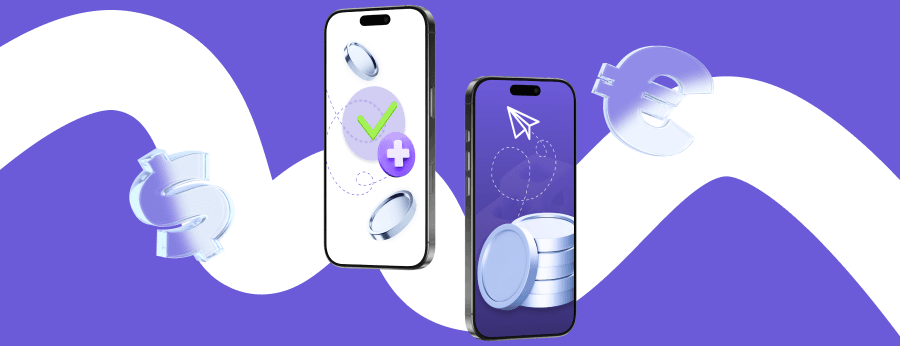Real-Time Gross Settlement is a major electronic funds transfer system. It is used for large exchanges between banks in India and around the world. The system provides instant settlement of payments, which makes it the best option for individuals and institutions. To better control the costs, users need to understand the full form of RTGS, how the system works and its benefits in detail.
Read the article to learn the definition of the system, the working process, the fees and the limits! If you are looking to make large transactions or just want to learn about the most secure funds transaction system in detail, this article is a must read.
What is RTGS?
RTGS abbreviation stands for Real-Time Gross Settlement. It is a system for fast and secure bank transfers of funds. Users can use this service to make large exchanges. Also, this system is supported by the RBI.

Unlike other electronic funds transaction systems, this system settles exchanges individually. As soon as the bank debits money from one account, it immediately credits it to the recipient’s account. And all this without any delay for batching!
RTGS is especially useful in the banking sector for businesses, government payments and urgent transfers of funds between banks. It ensures high levels of security and speed for all types of digital payments.
RTGS Full Form
The full form of RTGS is Real-Time Gross Settlement. Let’s break this term down:
- “Real-Time” means that the transaction is processed immediately;
- “Gross Settlement” means that the funds are settled on an individual basis.
This term highlights the main advantage of the system — final and irreversible settlement at the time of transaction.
In India, this system is regulated by the central bank, i.e. the RBI. This ensures its reliability across all major banks.
How Real-Time Gross Settlement Works
Exchanges are handled one at a time under the Real-Time Gross Settlement money transfer mechanism. Unlike batch systems, RTGS settles each transaction in real time and on a gross basis. This means that payments are not pooled. Real-Time Gross Settlement is an ideal tool for large exchanges. The service ensures that the transaction cannot be reversed, which makes it extremely secure. Let’s look at how it works step by step:
- Initiate the RTGS transfer. A user who wants to start an RTGS can visit their bank or use online banking channels.
- Verification by the bank. Upon request, the bank’s system will check the correctness of the information. Then, the bank authorizes the transaction with internal checks and security layers.
- Processing via the RTGS. The sending bank interacts with the RTGS system. The full money amount is instantly debited from the sender's bank account and credited to the recipient's bank because the bank employs gross settlement.
- Final settlement. The Reserve Bank of India guarantees immediate transfers between banks. Once a bank completes a transaction, the user cannot cancel it. Usually, both parties receive confirmation of a successful transaction within a few seconds or minutes.
As you can see, RTGS is a secure system for transferring large amounts in real time. The system makes exchanges as efficient as possible for any category of users.
Key Features and Benefits of RTGS
A lot of users choose RTGS for large value exchanges due to its unique features. Below you will find the main features and benefits of this system:
- Real-time settlement. RTGS processes each transaction instantly and without any delay.
- Gross settlement basis. The system processes each transaction individually and does not combine with other payments.
- Large value exchanges. RTGS has a minimum transaction limit of 200,000 INR, with no maximum limit.
- Security. Since the system adheres to strict security standards, RTGS transactions are protected from fraud by advanced encryption technology.
- Final transactions. Once processed, RTGS exchanges are final. This reduces the risk of settlement.
- 24x7 RTGS access. RTGS is available 24x7, including weekends and holidays, when using internet or mobile banking. However, bank branches may still process RTGS requests only during their official working hours.
- Available online and offline. You can start Real-Time Gross Settlement through internet banking, mobile banking and also at a bank.
RTGS is a secure system for transferring large amounts of funds. Real-time processing and gross settlement approach make it one of the best banking services.
RTGS Transfer Amount Limits in India
Real-Time Gross Settlement is specially designed for large transactions. It is suitable for corporate remittances, bulk payments or emergency large remittances. According to RBI guidelines, RTGS operates with a minimum transaction threshold. Take a closer look at the existing limits:
- Minimum transaction amount — 200,000 INR;
- No maximum limit.
Due to this RTGS threshold, the service’s customers can only use the service for large exchanges and not for everyday or retail remittances. Please note that attempting to transfer an amount less than 200,000 INR through RTGS will definitely not be successful. Consider using NEFT or IMPS if you wish to send a modest amount securely.

Also, the limits may differ between offline transfers and online transfers through net or mobile banking platforms. To better understand how these limits apply to different types of transfers, check out our detailed guide on RTGS limits.
Real-Time Gross Settlement Timings
RTGS is available 24/7, even on weekends and holidays. All thanks to the latest updates from RBI.
However, individual bank branches may restrict RTGS during certain hours for personal queries. You can utilize RTGS to make a transaction at any time if you use online or mobile banking.
For a deeper look at how fast transfers happen and what affects their speed, check our complete guide on RTGS transfer time.
Always check with your bank for the exact timings of the RTGS window, especially if you are planning to transaction a large amount from a bank branch.
How to Initiate an RTGS Fund Transfer and How It Works
Initiating an RTGS transfer is very easy. You can transfer money through two main channels — offline at a bank branch or online. Each method allows you to conduct a secure transaction in real time. Take a look at the main methods below.
| Feature | RTGS | NEFT | IMPS |
|---|---|---|---|
| Minimum Transfer | 200,000 INR | No minimum | 1 INR |
| Maximum Limit | No fixed limit (bank defined) | Varies by bank | 500,000 INR (usually) |
| Settlement Type | Real-time | Hourly/batch-wise | Real-time |
| Availability | Working hours | 24/7 | 24/7 |
| Speed | Instant | Within 30 min to 2 hours | Instant |
| Used for | High-value transactions, urgent payments | Non-urgent, flexible payments | Small, urgent payments |
| Access via | Branch, net/mobile banking | Net/mobile banking, branch | Mobile/internet banking, USSD |
| Charges (typical) | Free for both online and offline transfers at most banks | Mostly free | Nominal |
Initiate an RTGS: Offline Method
If you are transferring a large amount that exceeds your online banking limit, the offline RTGS method is the best option. Here’s how you can conduct the transaction:
- Visit the bank. Visit the bank and request an RTGS form.
- Fill the form. Fill the form with the required personal details.
- Submit the form. Submit the form to the bank staff, who will verify the information and verify your identity.
The bank will send the funds instantly through the RTGS. You will receive a confirmation message or receipt.
Initiate an RTGS: Online Method
Most banks offer RTGS exchanges online. This allows customers to conduct large exchanges from their home or office. Here is a step-by-step guide:
- Log in to the app. Log in to your internet banking or mobile app.
- Select the option you want. Go to the fund transfer section and select RTGS as the transfer type.
- Initiate the process. Add the beneficiary and enter the required details.
- Return to the section. Once the bank confirms the beneficiary, return to the transfer section.
- Enter the amount. Enter the transfer amount (must be 200,000 INR or more), select the beneficiary and submit the request.
- Complete authentication. Authenticate with the OTP or transaction password.
Your bank will process the request through the RTGS system and the transaction will be processed instantly.
Details Required for RTGS Transfers
To successfully complete a fund transfer, users need to provide the following details:
- Beneficiary name;
- Beneficiary account number;
- Beneficiary bank name and branch;
- Beneficiary branch IFSC code;
- Transaction amount.
Without complete details, the bank may delay or reject the RTGS transaction entirely. Always double check the form or online entry before submitting a request.
RTGS Charges and Fees
The RBI has waived processing charges for RTGS at the bank-to-bank level. However, individual banks may still charge customers. These charges depend on the mode of transfer, the transaction amount and the type of bank account. Take a closer look below.
Online RTGS Transfers
Most banks offer RTGS through net banking or mobile banking for free. However, some banks may still charge nominal charges, especially for corporate or non-retail accounts.
RTGS via mobile or internet banking is fast, simple, and convenient. A lot of public and private banks (like Bank of India, SBI and HDFC) offer zero charges for online exchanges.
Offline RTGS Transfers
As per the latest RBI directive, banks are not allowed to levy processing charges on RTGS transactions, whether online or offline. However, some banks may apply nominal service fees based on internal policy.
RTGS vs. NEFT vs. IMPS
RTGS, NEFT and IMPS are the three main systems that customers use to transfer funds electronically. The RBI regulates each of these systems. However, there are significant differences between them, which you will explore below:
We can explain that each system has a specific use case. RTGS is ideal for large and immediate exchanges. Use NEFT to conduct everyday banking. Choose IMPS when you need to transfer small amounts instantly, even outside of business hours. Learn these differences to optimize your money transfers.
What You Should Know Before an RTGS Transaction
Before initiating a transaction, a user needs to consider the following points:
- Check the minimum transaction amount. RTGS is specifically designed for large value exchanges. If your payment is below the available limit, use NEFT or IMPS.
- Have accurate bank details ready. Make sure to fill the form with up-to-date details. Errors in the details may result in transaction failure or delays.
- Be aware of deadlines and restrictions. Some banks may still observe time restrictions for RTGS fund transfers. Always check with your bank for RTGS operating hours.
- Transactions are final. Double check all input details before initiating an RTGS transfer. If an error occurs, refunds may require coordination between both banks.
Consider your preferences and the urgency of the transaction to select the appropriate channel for RTGS payment.
Summary
RTGS is an efficient banking service for large-value transfers in India. The service conducts exchanges in real time and uses reliable security protocols. Such qualities make it the best choice for individuals and large corporations. If you know how to use RTGS correctly, you can save time and enjoy peace of mind regarding the safety of your funds.
Online Payment Company #1
Online payment solutions for all types of businesses since 2019
Subscribe to stay updated
on industry news, insights, and exclusive offers


